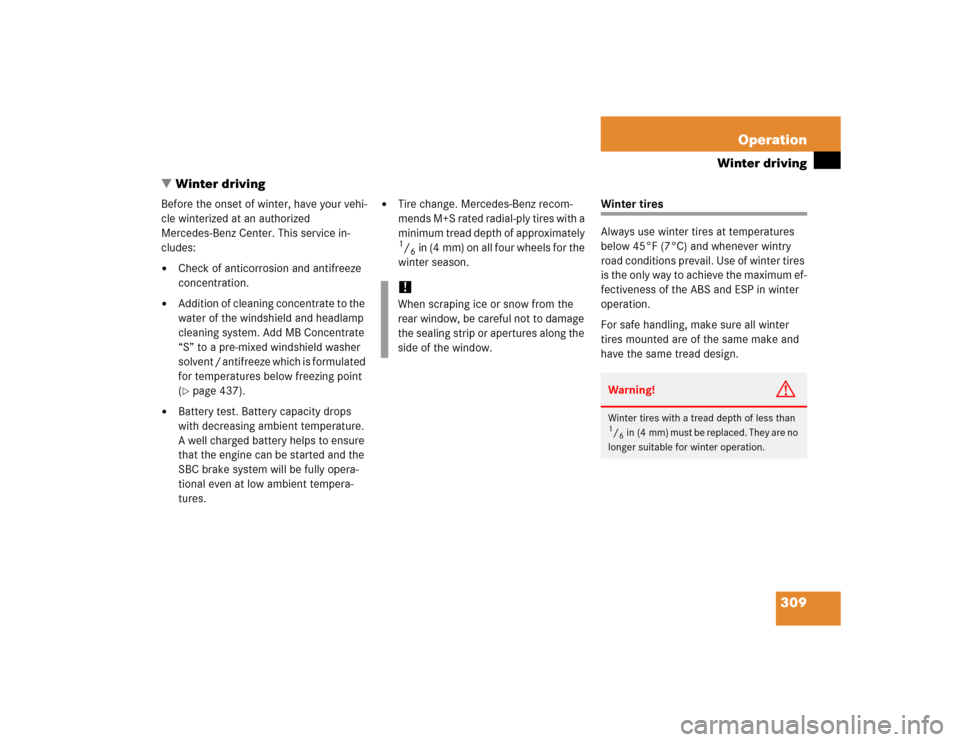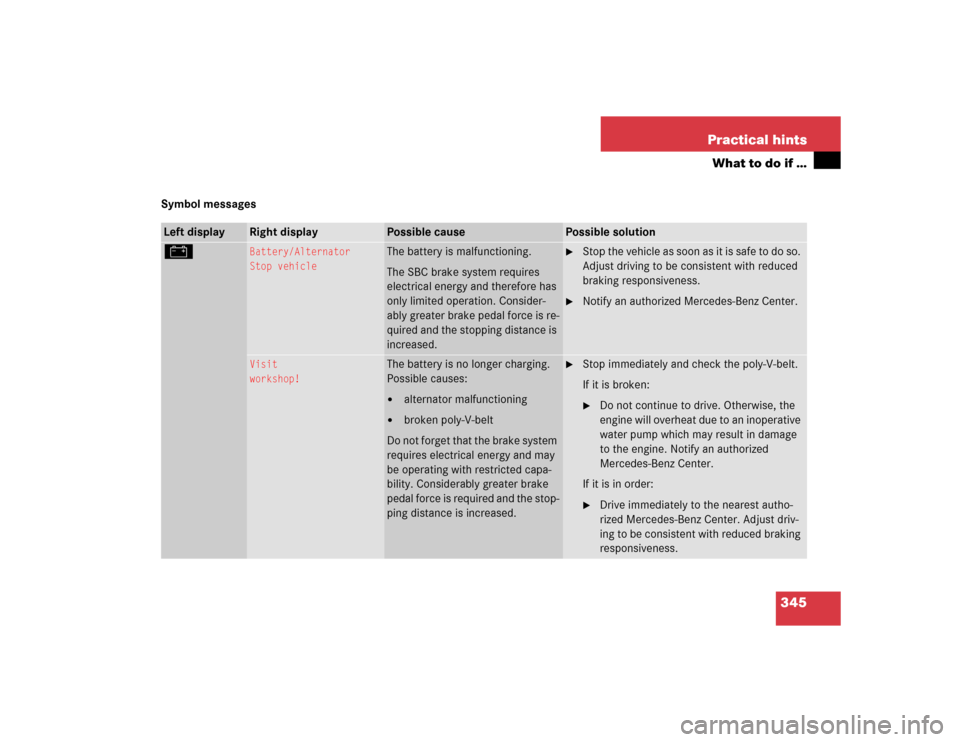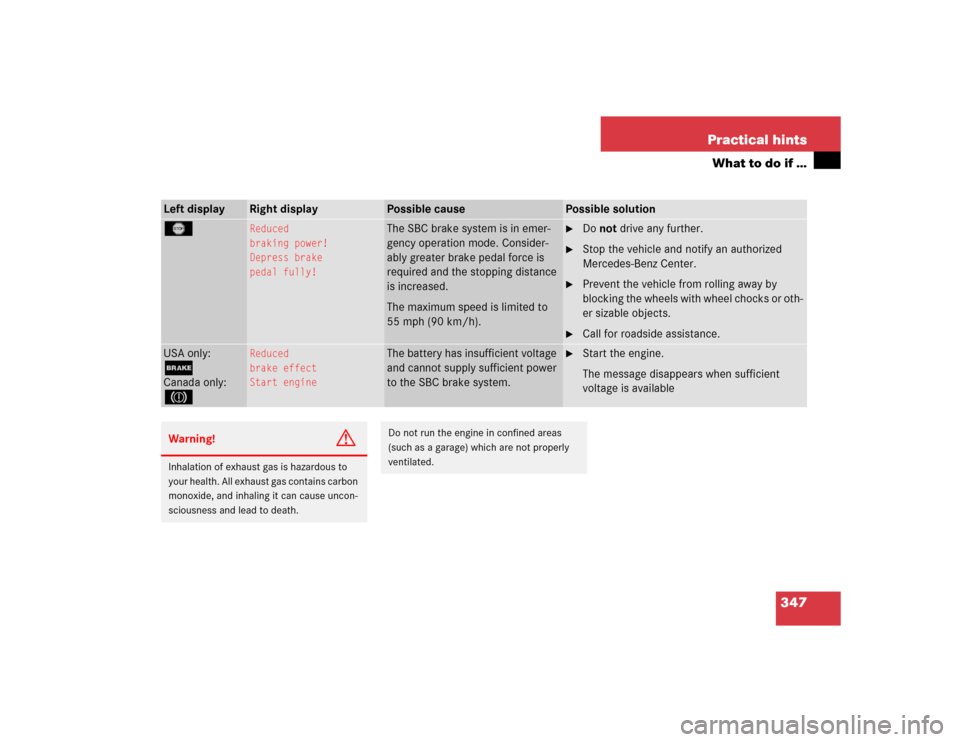Page 308 of 474

306 OperationTires and wheelsGVWR (G
ross V
ehicle W
eight R
ating)
This is the maximum permissible vehicle
weight of the fully loaded vehicle (weight of
the vehicle including all options, passen-
gers, fuel, and cargo and, if applicable,
trailer tongue load). It is indicated on
certification label located on the driver’s
door B-pillar.
Kilopascal (kPa)
The metric unit for air pressure. There are
6.9 kPa to one psi; another metric unit for
air pressure is bars. There are
100 kilopascals (kPa) to one bar.
Maximum load rating
The maximum load in kilograms and
pounds that can be carried by the tire.
Maximum loaded vehicle weight
The sum of curb weight, accessory weight,
vehicle capacity weight and production
options weight.Maximum tire inflation pressure
This number is the greatest amount of air
pressure that should ever be put in the tire
under normal driving conditions.
Normal occupant weight
The number of occupants the vehicle is
designed to seat, multiplied by
68 kilograms (150 lbs).
Occupant distribution
The distribution of occupants in a vehicle
at their designated seating positions.
Production options weight
The combined weight of those installed
regular production options weighing over
5 lbs (2.3 kilograms) in excess of those
standard items which they replace, not
previously considered in curb weight or
accessory weight, including heavy duty
brakes, ride levelers, roof rack, heavy duty
battery, and special trim.PSI (P
ounds per s
quare i
nch)
A standard unit of measure for air pressure
-> bar, kilopascal (kPa).
Recommended tire inflation pressure
Recommended tire inflation pressure
listed on placard located on driver’s door
B-pillar for normal driving conditions.
Provides best handling, tread life and
riding comfort.
Rim
A metal support for a tire or a tire and tube
assembly upon which the tire beads are
seated.
Sidewall
The portion of a tire between the tread and
the bead.
Page 311 of 474

309 Operation
Winter driving
�Winter driving
Before the onset of winter, have your vehi-
cle winterized at an authorized
Mercedes-Benz Center. This service in-
cludes:�
Check of anticorrosion and antifreeze
concentration.
�
Addition of cleaning concentrate to the
water of the windshield and headlamp
cleaning system. Add MB Concentrate
“S” to a pre-mixed windshield washer
solvent / antifreeze which is formulated
for temperatures below freezing point
(�page 437).
�
Battery test. Battery capacity drops
with decreasing ambient temperature.
A well charged battery helps to ensure
that the engine can be started and the
SBC brake system will be fully opera-
tional even at low ambient tempera-
tures.
�
Tire change. Mercedes-Benz recom-
mends M+S rated radial-ply tires with a
minimum tread depth of approximately 1/6in (4 mm) on all four wheels for the
winter season.
Winter tires
Always use winter tires at temperatures
below 45°F (7°C) and whenever wintry
road conditions prevail. Use of winter tires
is the only way to achieve the maximum ef-
fectiveness of the ABS and ESP in winter
operation.
For safe handling, make sure all winter
tires mounted are of the same make and
have the same tread design.
!When scraping ice or snow from the
rear window, be careful not to damage
the sealing strip or apertures along the
side of the window.
Warning!
G
Winter tires with a tread depth of less than 1/6in (4 mm) must be replaced. They are no
longer suitable for winter operation.
Page 316 of 474

314 OperationMaintenance
Resetting the maintenance service indicator
In the event that the maintenance service
on your vehicle is not carried out by an au-
thorized Mercedes-Benz Center, you can
have the maintenance service indicator re-
set. The automotive maintenance facility
carrying out the maintenance service will
find the information for resetting the main-
tenance service indicator in the mainte-
nance-relevant information for your
vehicle. Such information is available ei-
ther from an authorized Mercedes-Benz
Center or directly from Mercedes-Benz.
iIf the battery supplying the vehicle’s
electrical consumers is disconnected,
the days of disconnection will not be in-
cluded in the count shown by the ser-
vice indicator. To arrive at the true
service deadline, you will need to sub-
tract these days from the days shown
in the service indicator.
Do not confuse the service indicator
with the engine oil level indicator :.
!If the maintenance service indicator
was inadvertently reset, have an autho-
rized Mercedes-Benz Center correct it.
Only reset if the proper service has
been performed. Resetting the system
without performing proper service as
called for by the maintenance service
indicator will result in engine damage
not covered by the Mercedes-Benz
Limited Warranty.
��
Page 327 of 474

325 Practical hints
What to do if …
Problem
Possible cause
Suggested solution
-
The yellow ABS indicator lamp
comes on while driving.
The ABS has detected a malfunction and has
switched off. The BAS and the ESP are also
switched off (see messages in display).
The SBC brake system is still functioning nor-
mally but without ABS available.
If the ABS control unit is malfunctioning, oth-
er systems such as Parktronic*, Distronic*,
or the automatic transmission may also be
malfunctioning.
�
Continue driving with added caution.
Wheels may lock during hard braking,
reducing steering capability.
�
Have the system checked at an autho-
rized Mercedes-Benz Center as soon
as possible.
Failure to follow these instructions in-
creases the risk of an accident.
�
Read and observe messages in the
display (
�page 335).
The charging voltage has fallen below
10 volts and the ABS was switched off.
The battery may not be sufficiently charged.
�
Switch off electrical consumers that
are currently not needed, e.g. seat
heating.
�
If necessary, have the generator and
battery checked.
When the voltage is above this value
again, the ABS is operational again.
Page 347 of 474

345 Practical hints
What to do if …
Symbol messagesLeft display
Right display
Possible cause
Possible solution
#
Battery/Alternator
Stop vehicle
The battery is malfunctioning.
The SBC brake system requires
electrical energy and therefore has
only limited operation. Consider-
ably greater brake pedal force is re-
quired and the stopping distance is
increased.
�
Stop the vehicle as soon as it is safe to do so.
Adjust driving to be consistent with reduced
braking responsiveness.
�
Notify an authorized Mercedes-Benz Center.
Visit
workshop!
The battery is no longer charging.
Possible causes:�
alternator malfunctioning
�
broken poly-V-belt
Do not forget that the brake system
requires electrical energy and may
be operating with restricted capa-
bility. Considerably greater brake
pedal force is required and the stop-
ping distance is increased.
�
Stop immediately and check the poly-V-belt.
If it is broken:�
Do not continue to drive. Otherwise, the
engine will overheat due to an inoperative
water pump which may result in damage
to the engine. Notify an authorized
Mercedes-Benz Center.
If it is in order:
�
Drive immediately to the nearest autho-
rized Mercedes-Benz Center. Adjust driv-
ing to be consistent with reduced braking
responsiveness.
Page 348 of 474
346 Practical hintsWhat to do if …Left display
Right display
Possible cause
Possible solution
#
Visit
workshop!
There is a malfunction in the elec-
tronic system.
�
Have the system checked at an authorized
Mercedes-Benz Center as soon as possible.
#
Electric
consumers
offline!
The consumer battery has insuffi-
cient voltage and can no longer sup-
ply the convenience functions such
as seat ventilation*.
The electrical consumers will come back online
as soon as on-board voltage is sufficient.
2
Brake
wear
Visit
workshop
The brake pads have reached their
wear limit.
�
Have the brake pads replaced as soon as pos-
sible.
!Brake pad thickness must be visually
checked by a qualified technician at the
intervals specified in the Maintenance
Booklet.
Page 349 of 474

347 Practical hints
What to do if …
Left display
Right display
Possible cause
Possible solution
T
Reduced
braking power!
Depress brake
pedal fully!
The SBC brake system is in emer-
gency operation mode. Consider-
ably greater brake pedal force is
required and the stopping distance
is increased.
The maximum speed is limited to
55 mph (90 km/h).
�
Do not drive any further.
�
Stop the vehicle and notify an authorized
Mercedes-Benz Center.
�
Prevent the vehicle from rolling away by
blocking the wheels with wheel chocks or oth-
er sizable objects.
�
Call for roadside assistance.
USA only:;Canada only:3
Reduced
brake effect
Start engine
The battery has insufficient voltage
and cannot supply sufficient power
to the SBC brake system.
�
Start the engine.
The message disappears when sufficient
voltage is available
Warning!
G
Inhalation of exhaust gas is hazardous to
your health. All exhaust gas contains carbon
monoxide, and inhaling it can cause uncon-
sciousness and lead to death.
Do not run the engine in confined areas
(such as a garage) which are not properly
ventilated.
Page 360 of 474
358 Practical hintsWhat to do if …Left display
Right display
Possible cause
Possible solution
F
Key
Check battery
The batteries in the SmartKey with
KEYLESS-GO* are discharged.
�
Change the batteries (
�page 377).
Don’t forget
key
This message appears (for a maxi-
mum of 60 seconds) if the driver’s
door is opened with the engine shut
off and no SmartKey in the starter
switch.
Message is only a reminder.
�
Insert SmartKey in the starter switch.
�
Take the SmartKey with KEYLESS-GO* with
you when leaving the vehicle.
KEYLESS GO
Check system
The KEYLESS-GO* system is mal-
functioning.
�
Visit an authorized Mercedes-Benz Center as
soon as possible.
KEYLESS-GO
Drive to
workshop
The KEYLESS-GO* system is mal-
functioning.
�
Visit an authorized Mercedes-Benz Center as
soon as possible.